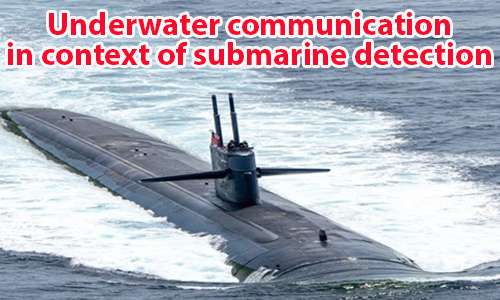
As we know 70 percent of planet covered with water and ignoring that can never be sustainable for future technology growth and economy based on technological solutions. There can be multiple applications of underwater communication and networking like disaster prediction, species identification and detection from defense perspective. We will focus only on submarine detection and challenges associated with that in this article. Submarine communication, detection and networking faces challenges based on technologies we consider as a fundamental medium of communication.

Three possible medium of communication we can consider for underwater applications like submarine detection.
Acoustic for Submarine Communication at far distance
Acoustic means we are talking about sound whether it is manmade or produced by equipment installed. Amazing thing about sound it can travel for a very short distance in an environment where we live. If we call or even shout, we can communicate our message at very short distance that we observe in our daily life. As we dive into deep water or oceans, we find complete opposite of what we observe in space. We can communicate for 1000 of meters in ocean by just sending a normal voice amplitude. We don’t have to even shout. That’s why we can see in real life submarines uses sound as a communication medium but at the cost of low speed 1500 m/sec which is very less compared to other communication options. Sound in underwater can be useful in long distance communication along with ocean species detection based on characteristics of sounds that species transmit or communicate with.
EM for accurate detection of submarine
EM (electromagnetic) means we are talking about waveform generated by movement of charges in an electronic device. In mobile, satellite, radar and space communication using EM is a preferable choice for both long range and at short distance for varying frequency from lower to higher respectively. EM waves are always susceptible to noise and environmental factors that can degrade communication and reduce tracking capabilities. As we know sound can be affected by other sounds generated by different species in ocean while EM does not face that kind of disturbance. Sound cannot cross sea/air boundary while EM can cross. There is dilemma with EM in underwater that it faces sudden exponential decay that makes it suitable for only short range in underwater environment. As compared to sound which takes much higher time after reflection from target compared to EM, which make EM more suitable for accurate position detection in context of submarine. EM takes few milliseconds (travel with speed of light 3*108 m/sec) after reflection from target that make it more accurate and help to identify target in short period of time compared to large delay in sounds. Sound can affect other species while EM at low frequency with less transmitted power less harmful for oceans species.
Optical for better classification of submarine
Optical means light that is a fundamental for capturing image both in space and underwater. In real life we observe that a simple camera can capture image at few meters far from observer. If we move beyond that distance quality of image in term of pixels deteriorated. While in context of underwater environment light can travel only few centimeters or 1-2 meters maximum. Sound considered to be suitable for long range communication and EM better suitable for short range accurate detection of targeted submarines. If a submarine is equipped with camera outdoor it can help to capture image at a very short distance for better classification of targeted objects or species. Sounds normally considered to be suitable for shallow water while EM for both shallow and deep oceans. Optical imaging better suitable in shallow waters. Optical in a short range can be dangerous for living species in oceans with the advantage of better classification of targeted submarine.
There are multiple application of underwater communication and networking in deep oceans. We mainly focused on underwater communication medium and suitability of different communication ways. In terms of submarine, we can see that for communication, networking and classification choosing right option is a better way forward. For developing our own underwater submarine communication systems; analysis based on given data provided by national center for environmental information of oceans or experimental testing of existing directed encapsulated antenna in rivers or lake is future. Pakistan technological development in underwater cannot be relied only on excessive publication or projects in documents but promotion of real time testing and development.
By Dr. Muhammad Tahir
“Currently working as an assistant professor in the department of engineering & computer science, NUML (Faisalabad Campus), Pakistan. He completed his Ph.D in information & communication engineering from school of electronics and information engineering, changchun university of science and technology, PR China. Major research interests include information and signal processing, underwater wireless communication using EM waves and energy optimization in WSNs.”
